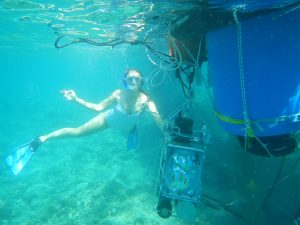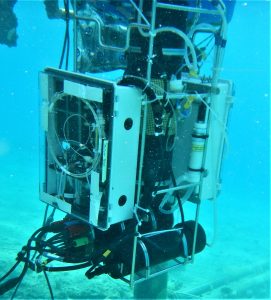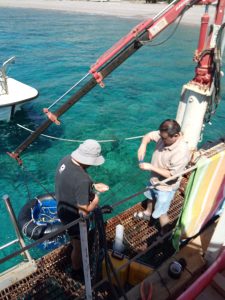Nuclei-Induced Inorganic Carbonate Precipitation
A fundamental pathway in the marine carbon cycle is the formation of calcium carbonate (CaCO3), which is typically attributed to biological calcification of shells and skeletons. While most surface seawater in both open and coastal oceans is supersaturated with CaCO3, inorganic CaCO3 precipitation is inhibited by several factors including the presence of dissolved organic carbon or Mg2+. Because of this, abiotic CaCO3 precipitation is typically assumed to be an insignificant pathway in carbon cycling. However, laboratory experiments have shown that seeding solid particles, or nuclei, into seawater supersaturated with CaCO3 triggers nuclei-induced inorganic carbonate precipitation (NICP). This has been observed in some unique settings, such as Little Bahama Banks and the deep Red Sea, but conditions of carbonate supersaturation and high suspended sediment loads may be common enough in coastal oceans that NICP may be an important factor in coastal carbon cycling.
The goal of this project is to evaluate the significance of NICP caused by flood sediment and dust resuspension in coastal waters through a series of laboratory-based kinetic experiments as well as a series of instrumented coastal mesocosm experiments. These in-situ mesocosm experiments take place in the coastal Red Sea at Eilat, Israel, to take advantage of the warm water temperatures, high CaCO3 supersaturation, and large particle inputs from the surrounding desert.
Preliminary field work
In June/July 2019, we ran a series of in-situ mesocosm experiments at the Interuniversity Institute for Marine Sciences at Eilat, Israel. Analysis and improvement of these experiments is underway, with a follow up field season planned for spring 2021.
- Pier at IUI
- Sensor suite attached to mesocosm experiment
- Aleck Wang and Boaz Lazar setting up the mesocosm experiment

Funding Agencies
The US National Science Foundation (NSF) and the US-Israel Binational Science Foundation (BSF) under grant number 1635388 funded this research.
Partners/Collaborators
This is a joint project with WHOI (PI Dr. Aleck Wang and co-PI Dr. James Churchill), Texas A&M (co-PI Dr. Timothy Dellapenna), Hebrew University of Jerusalem (co-PI Dr. Boaz Lazar), Dr. Eyal Wurgaft (now of the Open University of Israel), and Gilli Evardson.
This research is part of a larger investigation on NICP in coastal settings triggered by airborne dust deposition, flash flooding, river influx, and bottom sediment resuspension, of which my thesis projects focus on dust and floods.
Research Papers
- Submitted for peer review:
- Wurgaft E., Wang, Z.A., Churchill, J.H., Dellapenna, T.M., Song, S., Du, J., Ringham, M.C., Rivlin, T., and Lazar, B. 2021. Particle triggered reactions as an important mechanism of alkalinity and inorganic carbon removal in river plumes. Geophysical Research Letters, doi: 10.1029/2021GL093178)
- Watch this space for our next paper.


